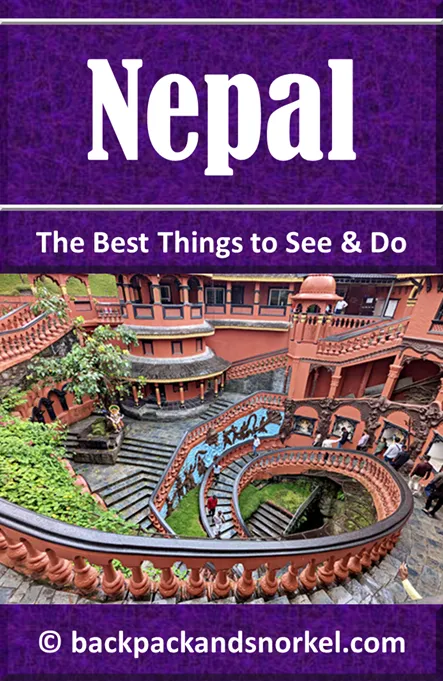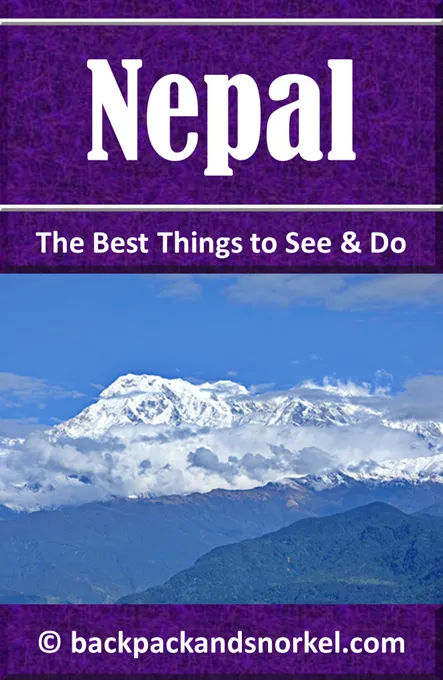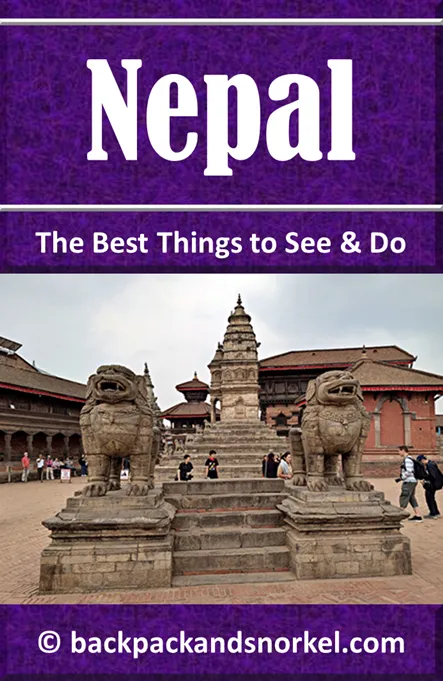Exploring Hanuman Dhoka Palace: Courtyards, Museums & Royal History in Kathmandu - Nepal Purple Travel Guide
(map, reviews)
This is Premium Content! To access it, please download our
Backpack and Snorkel Purple Travel GuideKeep walking to the left (east), until you see the orange-red brick Hanuman Dhoka Palace to your left, directly after the whitewashed walls of Gaddi Baihak.
Hanuman Dhoka Palace is one of the most important historical landmarks in Nepal. This sprawling palace complex served as the royal residence of the Malla kings and later the Shah dynasty rulers, making it a key center of political and ceremonial power for centuries.

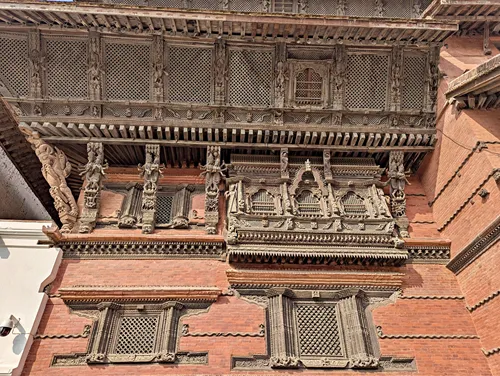
Here at Backpack and Snorkel Travel Guides, we typically promote self-guided walking tours.
But we realize that not everybody likes to walk by themselves in a foreign city. So, just in case that you rather go with ab guide: NO PROBLEM! Please see the Viator tours below.
free GuruWalk tours
paid Viator tours
Origin of the name Hanuman Dhoka Palace
The name Hanuman Dhoka comes from two words:
Hanuman: the revered monkey god in Hindu mythology, known for his unwavering devotion and strength.
Dhoka: means ‘gate’ in Nepali.
The name refers to the statue of Hanuman placed at the palace entrance in 1672 by King Pratap Malla. Believed to guard the palace from evil, this weather-worn idol still stands today, draped in red cloth and smeared with vermillion by worshippers who revere it as a protective force.
Historical and Cultural Significance of Hanuman Dhoka Palace
Hanuman Dhoka Palace was originally constructed in the 4th century, but much of what you see today dates from the 16th to 18th centuries, during the Malla period. The complex grew in size and grandeur as rulers added new wings, courtyards, and temples. When the Shah kings unified Nepal, they continued to use the palace for coronations and royal ceremonies until the late 19th century.
Inside the palace complex are a series of beautifully designed courtyards (chowks) such as Nasal Chowk, Mul Chowk, and Basantapur Durbar. These spaces were used for everything from royal rituals to state meetings. There are also shrines, throne rooms, and residential quarters, along with a museum that showcases royal artifacts, historical photographs, and ceremonial regalia.
Architecture of Hanuman Dhoka Palace
The architecture of Hanuman Dhoka reflects the brilliance of Newar craftsmanship, blending Hindu and Buddhist motifs. The palace features intricate wooden windows, tiered rooftops, and ornate doorways, showcasing the artistic and cultural richness of the Kathmandu Valley. Despite damage from the 2015 earthquake, much of the palace has been restored, and preservation efforts continue.
Modern Use and Visitor Experience of Hanuman Dhoka Palace
Today, Hanuman Dhoka functions as a museum complex, giving visitors a deep dive into Nepal’s royal history, architecture, and spiritual heritage.
When you stand in front of the orange-red brick Hanuman Dhoka Palace, you will see that two features are sticking out:
The tall pagoda-style building on the left. This is the Nine Storey Palace.
The door with the gorgeous wooden ornamentation that is centered a bit to the right. The door is called Hanuman Dhoka
Nine Storey Palace
(map, reviews)
This is Premium Content! To access it, please download our
Backpack and Snorkel Purple Travel GuideRising above the historic heart of Kathmandu Durbar Square, the Nine Storey Palace, also known as Basantapur Tower, is one of the most iconic landmarks in the Kathmandu Valley. With its soaring structure and elegant Newar architecture, it once served as the royal watchtower and a symbol of monarchical power during Nepal’s Malla and Shah dynasties.

Origin of the Name Nine Storey Palace
The name Nine Storey Palace refers directly to the building’s original height - a remarkable nine floors, making it the second tallest building in Kathmandu Durbar Square – only Taleju Bhawani Temple is taller. Locally, it’s called Nau-Talle Durbar (‘Nau’ meaning nine and ‘Talle’ meaning stories or floors). The alternative name, Basantapur Tower, comes from the Basantapur Durbar complex, where the palace is located.
This impressive structure was commissioned by King Prithvi Narayan Shah in the 18th century after he unified the Kathmandu Valley. While the exact year is not definitively recorded, it is generally believed to have been constructed shortly after the unification of the Kathmandu Valley, which was completed around 1769. The tower was added to the Hanuman Dhoka Palace complex and symbolized the Shah dynasty’s vision and power, offering sweeping views over the city and surrounding hills.
So, a reasonable estimate places the construction of the Nine Storey Palace in the 1770s, likely between 1770 and 1780.
Historical and Cultural Use of the Nine Storey Palace
The Nine Storey Palace was used:
as a royal lookout point, especially during military times.
for observing festivals and public events held in the square below.
as a space for private royal rituals and meditation.
to house important government offices and court functions.
Its height and grandeur also served a symbolic purpose — asserting the dominance of the royal house over the valley’s skyline.
Architecture and Design of the Nine Storey Palace
The tower is a fine example of Newar architecture, showcasing richly carved wooden windows, brick latticework, and tiered pagoda-style roofs. Despite its height, it was built entirely with traditional materials and techniques, reflecting the ingenuity of Newar craftsmen.
The interior features narrow staircases, wooden beams, and viewing platforms. The higher levels of the Nine Storey Palace collapsed during the 2015 earthquake, but their exterior was rebuilt in 2023. Restoration efforts of the interior are currently ongoing.
Visitor Information for the Nine Storey Palace
As part of the Kathmandu Durbar Square UNESCO World Heritage Site, the Nine Storey Palace is a popular attraction for those interested in Nepali history, architecture, and royal heritage. Access to the upper levels is currently limited due to the ongoing structural restoration.
Currently, when you visit the Hanuman Dhoka Palace Complex, you will most likely see these places:
Hanuman Dhoka
Nasal Chowk
Naag Pokhari
King Mahendra Jeep
Plaza in Front of the Private Royal Quarters and Bilas Mandir
Hanuman Dhoka
(map, reviews)
This is Premium Content! To access it, please download our
Backpack and Snorkel Purple Travel GuideHanuman Dhoka is the main entrance to the Hanuman Dhoka Palace Complex, once the seat of power for the Malla kings and later the Shah dynasty.
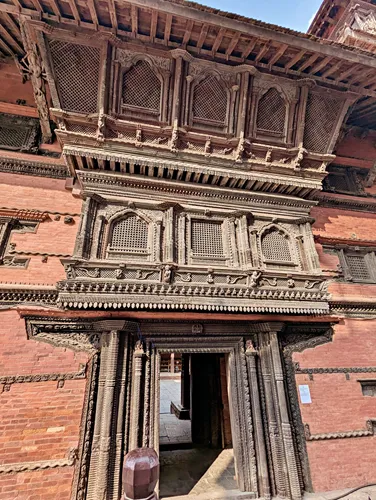
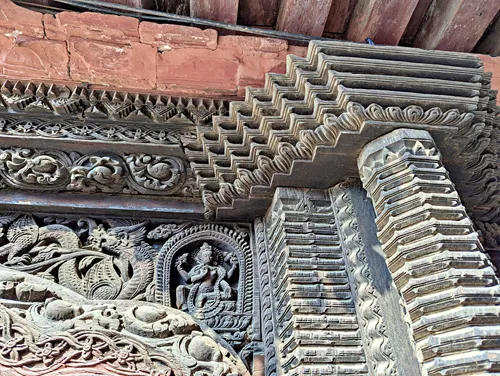

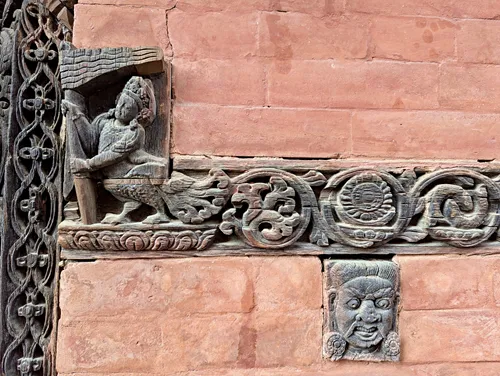
As mentioned earlier, the name comes from two key elements:
Hanuman: the monkey god from the Hindu epic Ramayana, revered for his strength, loyalty, and protection.
Dhoka: the Nepali word for ‘gate’.
Hanuman is a highly revered deity in Hinduism, known for his unwavering devotion, strength, and courage. Here is more information:
Devotee of Rama
Hanuman is most famously known as the devoted follower of Lord Rama, a central figure in the Hindu epic, the Ramayana. His loyalty and service to Rama are exemplary.Monkey God (Vanara)
He is often depicted as a monkey-like being, or ‘Vanara’, possessing extraordinary physical abilities.Symbol of Strength and Courage
Hanuman is celebrated for his immense strength and bravery, which he used to aid Rama in his battles against evil.Symbol of Devotion
His unwavering devotion to Rama makes him a symbol of ideal devotion and selfless service.Key Role in the Ramayana
Hanuman plays a crucial role in the Ramayana, particularly in the rescue of Rama's wife, Sita, from the demon king Ravana.Worship and Reverence
Hanuman is widely worshipped throughout India and Nepal.
He is considered a protector and is often invoked for strength, courage, and protection from evil.
Historical and Cultural Significance of Hanuman Dhoka
Don’t let the of the gate size fool you, Hanuman Dhoka is more than an entryway – it is a symbol of power, protection, and tradition. It served as the ceremonial and functional gate to the Hanuman Dhoka Palace, a sprawling complex that was the official residence of the royal family until the late 19th century.
The gateway itself is richly decorated with traditional Newar woodwork and carvings, blending artistic beauty with spiritual symbolism. For centuries, kings, queens, and dignitaries passed through this gate during coronations, rituals, and festivals.
Your Kathmandu Durbar Square entrance ticket grants you access to the interior of Hanuman Dhoka Palace. Due to ongoing restoration work, it is to be understood that some places that may be open today may be closed tomorrow.
Nasal Chowk
(map, reviews)
This is Premium Content! To access it, please download our
Backpack and Snorkel Purple Travel GuideEnter the palace complex through Hanuman Dhoka, and you will get into a courtyard called Nasal Chowk.
The name Nasal Chowk comes from the Sanskrit word ‘Nata’, meaning dance. Nata is associated with Natareshwor, a form of the Hindu god Shiva depicted in a dancing pose. A small shrine to Nasal God (dancing Shiva) sits in one corner of the courtyard, giving the space its name.
The word ‘chowk’ has its origins in Hindi and Sanskrit, and means courtyard.
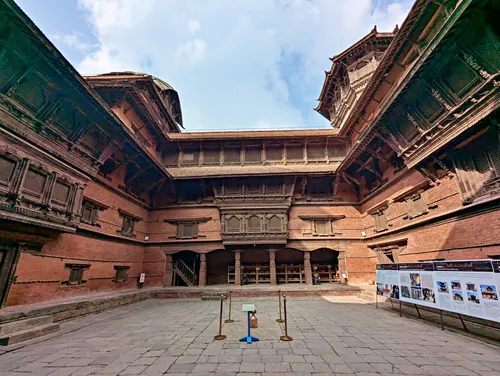
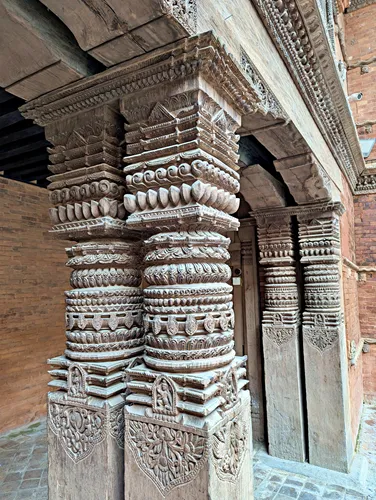

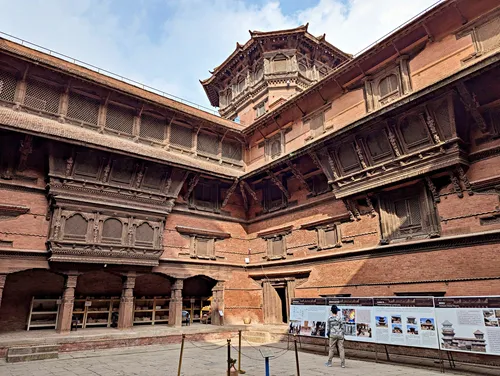
Historical Use and Significance of Nasal Chowk
Built in the 17th century by the Malla kings, Nasal Chowk served as the main ceremonial courtyard of the palace. It continued to be used by the Shah dynasty, even after the unification of Nepal by King Prithvi Narayan Shah in the 18th century.
Key uses of Nasal Chowk included:
Royal coronations - Kings of Nepal were formally crowned here, including the well-known King Tribhuvan, and where Birendra Bir Bikram Shah Dev, the last king of Nepal, was crowned as king in 1975.
Public audiences and state ceremonies
Religious rituals and festivals
Daily functions of the royal court
Architecture and Layout of Nasal Chowk
Nasal Chowk is a classic example of Newar courtyard architecture, a rectangular open space surrounded by intricately carved wooden balconies, windows, and multi-story palace wings. The design allows for both intimate ceremonies and grand events, with the space easily accommodating royal processions and sacred dances.
Several important buildings surround the courtyard, including:
The King’s audience chamber (Throne Room)
Coronation platform
Nasal God Temple (the shrine to dancing Shiva)
Despite being over 300 years old, the artistry in the woodwork and brickwork remains remarkably well preserved.
Naag Pokhari
(map, reviews)
This is Premium Content! To access it, please download our
Backpack and Snorkel Purple Travel GuideThe name Naag Pokhari comes from two Nepali words:
Naag: A mythical serpent deity in Hindu and Buddhist tradition, often associated with water and rain
Pokhari: A pond or water tank
Naags are considered protectors of water sources, and Naag Pokhari is believed to be a sacred home or offering site to these serpent spirits.
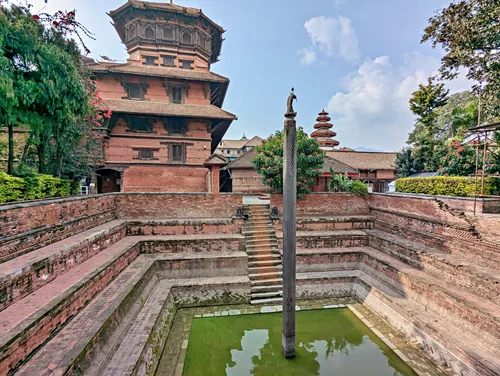



Naag Pokhari has a tall statue of a Naga King (Serpent God) at its center. It plays an important role during Naag Panchami, a festival where people honor serpent deities to bring rainfall, fertility, and protection from snakebites. On this day, devotees visit the pond to offer milk, flowers, and prayers to the naags.
Traditionally, such ponds were also part of palace complexes, used for both practical water storage and spiritual purposes. While the exact construction date of Naag Pokhari in Kathmandu Durbar Square is unclear, it has long been part of the ceremonial and religious landscape of the area.
King Mahendra Jeep
(map, reviews)
This is Premium Content! To access it, please download our
Backpack and Snorkel Purple Travel GuideAmong the ancient temples and medieval courtyards of Kathmandu Durbar Square, a somewhat unexpected yet fascinating artifact stands out: King Mahendra’s Jeep. Currently housed near Naag Pokhari, this vintage vehicle is more than just a car; it is a symbol of Nepal’s mid-20th-century transition from monarchy to modernity, and it played a role in an assassination attempt.
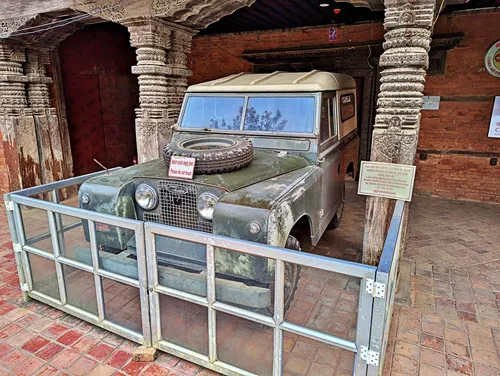
What Is King Mahendra’s Jeep?
This classic black jeep once belonged to King Mahendra Bir Bikram Shah Dev, the second king of the Shah dynasty in modern Nepal. Used during his reign in the 1950s and 60s, the jeep represents a time when the monarchy was modernizing, yet still deeply rooted in tradition.
In 1961, while King Mahendra was traveling in his jeep near Ramechhap, eastern Nepal, shots were fired and bombs were thrown at the vehicle in what was later revealed to be an attempted assassination. The king survived unharmed, and the jeep itself was said to have been damaged by bullets, though the extent is unclear.
This incident became part of the broader political tension of the time, as Mahendra had recently dissolved the democratic government and dismissed the first elected parliament, replacing it with his own Panchayat system. The attack was believed to be politically motivated, reflecting growing opposition to his autocratic move.
Origin of the Name King Mahendra’s Jeep
The jeep gets its name simply because it was used by King Mahendra himself, who ruled from 1955 to 1972. Known for his travels around the country and diplomatic missions abroad, King Mahendra is remembered for consolidating royal power and introducing the Panchayat system, a party-less political structure that shaped Nepalese politics for decades.
Plaza in Front of the Private Royal Quarters and Bilas Mandir
(map)
This is Premium Content! To access it, please download our
Backpack and Snorkel Purple Travel GuideConstructed in the mid-17th century during the reign of the Malla kings, Mohan Chowk is a courtyard inside the Royal Palace, which is surrounded by buildings primarily used for royal residence, state ceremonies, and possibly for educational or cultural gatherings.
The buildings provide access to Bilas Mandir and other interior temple spaces.
While Mohan Chowk and the buildings surrounding it cannot be visited at the time of writing, you will likely have access to the plaza in front of it. The plaza has several interesting exhibits behind glass panes that you can see.
Of interest is also that the buildings surrounding the plaza are in traditional Newar style and in whitewashed Rana-era influenced style. The Rana prime ministers, who ruled Nepal after the Shahs, made significant modifications to the Hanuman Dhoka complex.
Among the whitewashed buildings is a round pagoda that sticks out: Bilas Mandir
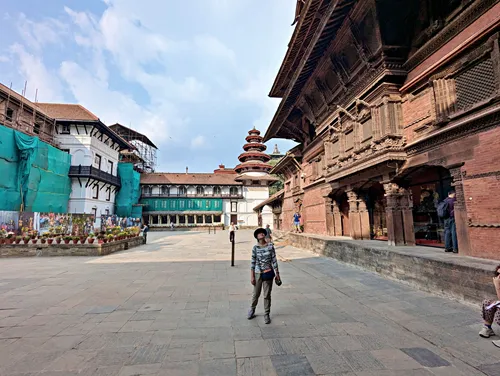
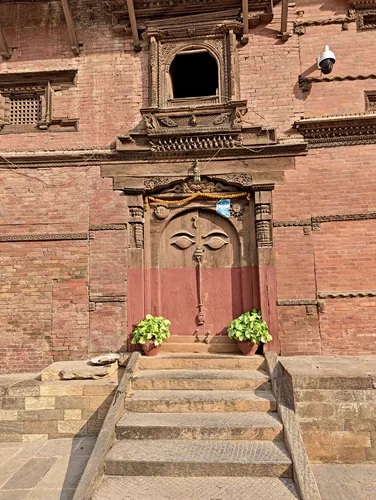
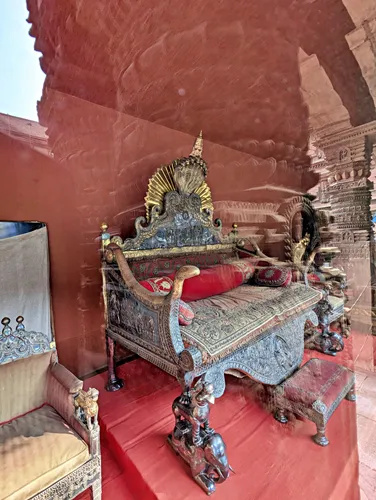
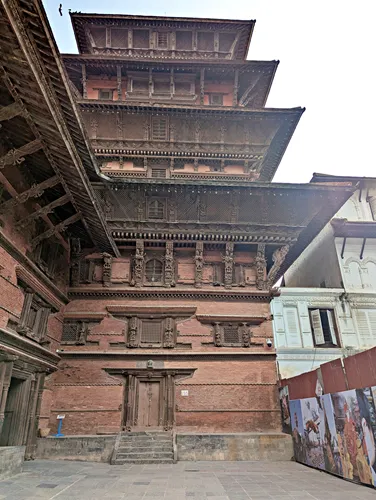
The word ‘Chowk’ in Nepali refers to a courtyard, and ‘Mohan’ is believed to be derived from a royal title or possibly a king’s name associated with the space. While exact documentation on the name's origin is limited, it likely reflects its connection to the royal court and inner residential areas of the palace, serving as a hub for elite and ceremonial functions.
The name ‘Bilas Mandir’ can be translated as the ‘Temple of Pleasure’ or ‘Temple of Leisure’, derived from the Sanskrit word ‘bilas’, meaning pleasure, delight, or recreation. The name hints at its use as a private place of worship and retreat for the Malla and Shah kings who once lived in the palace.
While not as elaborate or crowded as other temples in the square, Bilas Mandir’s serene setting and exclusivity reflect its purpose as a royal sanctuary, reserved for quiet prayer and inner reflection.
Historical Use and Significance
Bilas Mandir is believed to have been constructed during the Malla period, though precise dates remain unclear. It was built within the residential quarters of the palace, and was likely used by the king and royal family for daily worship, especially to Shiva or Vishnu, depending on the reigning monarch’s preferences.
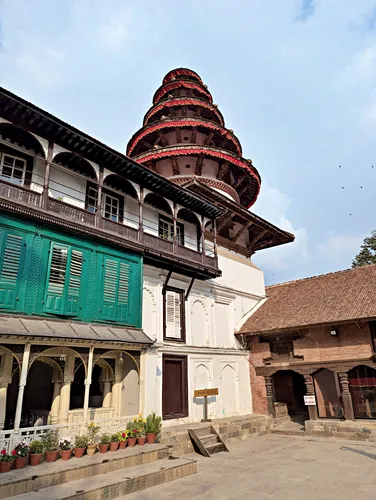
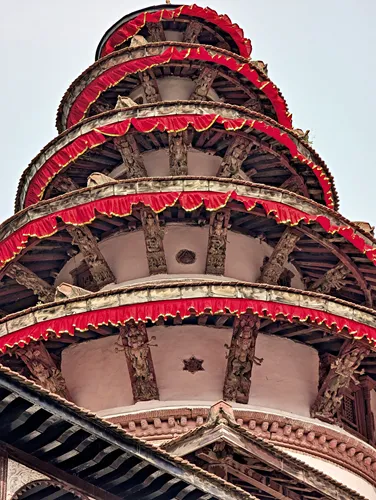
This concludes your Tour of the Royal Palace.
Back to your self-guided tour
Author: Rudy at Backpack and Snorkel
Bio: Owner of Backpack and Snorkel Travel Guides. We create in-depth guides to help you plan unforgettable vacations around the world.
Other popular Purple Travel Guides you may be interested in:
Like this Backpack and Snorkel Purple Travel Guide? Pin these for later:

